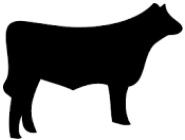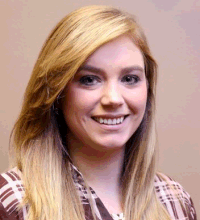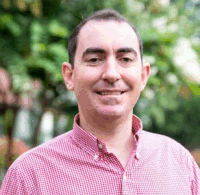

To send a message to an author, click on the author's name at the end of the article.
This Month in Ag Connection | Ag Connection - Other Issues Online
Frost seeding of legumes can be a very cost-effective method for the forage and livestock producer to improve pasture and hay field quality and quantity. Frost seeding of legumes is the act of broadcasting legume seed in the winter months on frozen ground, typically February in Missouri, and allowing the natural freezing and thawing of the soil to bury the seed. Frost seeding is not advised for sandy soil conditions due to the lack of proper freeze and thaw cycles needed for seed burial. Soils that typically work well for frost seeding are loams and clays. Also, if a dryer spring occurs, sandy soils may not hold enough moisture to carry an establishing legume seedling population. Sandy soils will typically be dryer or dry out more quickly in the spring due to their very nature. One of the biggest barriers the producer faces when attempting to establish frost seeded legumes in a grass stand, is the establishment of good seed to soil contact.
Seed to soil contact is critical when broadcasting or planting seed by any method, be it via conventional or no till. It can be troublesome in pasture and hayfield situations when a tall grass canopy or heavy residue remains in the winter months. A close fall/winter grazing or mowing prior to broadcasting any seed is critical so the broadcast seed can make it through the grass canopy to the soil surface. Many pastures have been set back in production due to the drought of 2023, fall drought of 2022, and reduced fertilizer applications due to the high cost of nitrogen fertilizer in 2022. These stressed pastures and hayfields provide an excellent opportunity for successful frost seeding of legumes.
Before broadcasting occurs, ensure adequate fertility levels and pH are set, otherwise, establishment and persistence may be lackluster at best. A soil test is an absolute necessity when planning to establish any legume species.
Typical legume species that bode well in Missouri for frost seeding are red clover, white clover, and annual lespedeza. Typical broadcast rates for red and white clover are two and eight pounds per acre, respectively. Fifteen pounds per acre broadcast is what is recommended for annual lespedeza. It is advisable to treat seed with rhizobium inoculum before broadcasting if that particular legume has not been grown in that field in the last two to three years. Legume species have specific inoculum which are needed to conduct symbiotic nitrogen fixation. Inoculum is relatively inexpensive and a good insurance policy. Fields that have been flooded may benefit from inoculum treated legume seed regardless of time between the last legume crop grown in the field. Flooding kills rhizobium bacteria in the soil.
Nitrogen applied in the spring following a frost seeding should not exceed 25 pounds, otherwise grasses will outcompete the seedling legumes and nitrogen fixation rates will be reduced if not halted completely. Once legumes make up 30-35 % of the stand density in mixed legume-grass pastures or hay fields and are uniformly and evenly established throughout the field, nitrogen application costs will dwindle because there is enough excess nitrogen produced by the legume/bacterium symbiosis. This effectively reduces the need for nitrogen application to the field to zero. It is wise to not look at this as a whole farm system but as a field-by-field system that should be utilized over a period of years. Forage production in total will be reduced in a grass monoculture until legume stand densities achieve optimum levels to supply adequate nitrogen rates to the companion grasses. Switching the whole farm over to a legume renovation management scheme at once may lead to inadequate forage production and carries a much higher risk if weather does not cooperate for legume establishment. Once legumes are established, they will be able to compete adequately with grasses.
During legume establishment it is advisable to postpone spring nitrogen applications until August to encourage grass growth in the fall and allow legumes to establish in the wetter spring and compete with rapid grass growth. Legumes require continuous stand maintenance and one seeding may only last three years (stand establishment time and longevity is species, variety, and growth environment specific). It is also important the legumes chosen pair well with the field soil drainage classification.
Many producers apply broadcast frost seeded legumes over a light dusting of snow to help keep track of their passes and spread swath. It is not advised to spread on a heavy snow because melting runoff will carry small legume seed with it. It is very important to calibrate any seed planting or broadcasting equipment before going to the field, as negative financial ramifications can occur for a multitude of reasons, which compound as acreage to be covered increases. Follow manufacturer instructions for calibration. Calibration is of even greater importance when utilizing rental equipment. Several Extension guides and videos are available that walk the producer step by step through the calibration process for several types of broadcast seeding and planting equipment.
Source: Nick Wesslak, Agronomy Specialist
This Month in Ag Connection | Ag Connection - Other Issues Online
The Northeast Missouri Show-Me-Select Replacement heifer sale averaged $2,705 at F & T Livestock Market, Saturday, December 9.

The 21 producers of the 342 heifers were enrolled in the MU educational heifer management program. The heifers were bred to sires with both calving-ease and growth genetics. The top lot sold belonged to Prairie View Farms, Monroe City and brought $3,900.
The highest average price from a consignor was $3,111 on twenty head from long-time consignor Prairie View Farms, Monroe City. Other top consignors were Keithley/Jackson, Frankford, $2,965 on 26 head and Beach Cattle Co, Leonard, $2,942 on 7 head.
The 45 buyers were responsible for just over $925,000 worth of bred heifers exchanging hands in one and a half hours. Thirty-five repeat buyers purchased 286 head, or 84 percent of the total consignment. Calving surveys returned by these buyers provide important information which is given back to consignors to improve for future years.
The Show-Me-Select heifer development program takes nearly a year to complete. The heifers complete a pre-breeding examination usually four to eight weeks before breeding. This exam includes a pelvic measurement, reproductive tract score, and weight. Heifers may be bred artificially or be exposed to natural service, however; the service sires must meet specific calving ease Expected Progeny Difference (EPD) requirements based on breed. This year 157 head, or 46 percent, of the heifers in the sale were synchronized and bred by artificial insemination (AI). In this sale, the choice to AI showed a $129 price advantage over those bred naturally.
All heifers must be pregnancy tested within 90 days of breeding by a veterinarian to determine expected calving date. The use of ultrasound has helped many of the veterinarians improve their accuracies on calving dates. During the development period all heifers undergo an extensive health program and are vaccinated at weaning, pre-breeding, and pregnancy examination as well as treated several times for internal and external parasites. Heifers are also screened for blemishes, condition, muscling and structural soundness by MU livestock specialists and USDA graders.
Averages of other Show-Me-Select sales from fall 2023 were Joplin, $2,906 on 85 head; Kirksville, $2,693 on 126 head; Kingsville, $2,883 on 181 head; SEMO, $2,711 on 43 head; and Farmington, $2,599 on 131 head.
This was the 27th year for the Show-Me-Select heifer sale in Palmyra and over 47,304 heifers have been through the program and 8,481 head have been sold. If you are interested in participating contact your local MU Extension livestock specialist.
Source: Daniel Mallory, Livestock Specialist
This Month in Ag Connection | Ag Connection - Other Issues Online
Coming Soon...
Selling Local Foods Workshop
Feb. 15th
Hannibal, MO
For more information call Pike Extension Office: 573-324-5464
This Month in Ag Connection | Ag Connection - Other Issues Online
The following list is for in-person training. Pre-registration is required at least one business day prior to the training. Each site has limited seating. The training is for farmers needing to obtain or renew a private pesticide applicator's license.
For questions call Valerie Tate (660)-895-5123 or Nick Wesslak (573) 769-2177.
Adair County - Feb. 5 @ 10 a.m.
Adair Extension office, 660-665-9866
Audrain County - Feb. 20 @ 6 p.m..
Courthouse Basement, 573-581-3231
Chariton County - Feb. 26 @ 10 a.m.
Chariton County Courtroom, 660-288-3239
Clark County - Feb 8 @ 10 a.m. or 2 p.m.
FBC Kahoka Gymnasium, 660-727-3339
Cooper County - Feb 7 @ 12 noon MFA Training Ctr or 6 p.m. Pilot Grove Coop Shop,
660-882-5661
Knox County - Feb 15 @ 10 a.m. or 2 p.m.
Greenley Research Center 660-397-2179
Lewis County - Feb. 7 @ 10 a.m. or 2 p.m.
Courthouse, 573-767-5273
Linn County - Feb. 26 @ 2 p.m.
MU Cornett Farm, 660-895-5123
Macon County - Feb. 19 @ 10 a.m.
POET Mtg Room, 660-385-2173
Marion County - Feb. 20 @ 10 a.m. or 2 p.m.
Sesquicentennial Bldg, 660-385-2173
Moniteau County - Mar. 14 @ 6 p.m.
California H.S. Vo. Ag. Bldg, 573-378-5358
Monroe County - Feb. 13 @ 10 a.m. or 2 p.m.
Monroe Extension office, 660-327-4158
Morgan County - Feb. 1 @ 9:30 a.m. Morgan County Seed or 2 p.m. Morgan Extension Center,
573-378-5358
Pike County - Feb. 8 @ 6 p.m.
Pike Extension Ctr/Courthouse Annex, 573-324-5464
Putnam County - Feb. 12 @ 2 p.m.
4-H Building, 660-947-2705
Ralls County - Feb. 1 @ 10 a.m. or 2 p.m.
Ralls Courthouse Basement, 573-985-3911
Randolph County - Feb. 19 @ 2 p.m.
Randolph Extension Office, 660-895-5123
Schuyler County - Feb. 5 @ 2 p.m.
Courthouse basement, 660-457-3469
Scotland County - Feb.6 @ 10 a.m. or 2 p.m.
Scotland County Fire Dept., 660-465-7255
Shelby County - Feb. 28 @ 10 a.m. or 2 p.m.
Shelby Extension office, 573-633-2640
Sullivan County - Feb. 12 @ 10 a.m.
City Hall Community Room, 660-895-5123
This Month in Ag Connection | Ag Connection - Other Issues Online

Mag Lopez Soriano - a livestock field specialist focusing on swine. He is located in Columbia at the Missouri Pork Producers Association and will serve all counties. He will assist pork producers with animal health, nutrition, genetics, reproductive and manure management, economics and facilities. He has work experience in Honduras, Costa Rica and the U.S. He has designed field trials for the development of the Pink Pineapple in Costa Rica, worked closely with the Costa Rican government to control the stable fly and led a large-scale renovation project for a farm of 10,000 sows.

Jamie Courter - state beef genetics specialist in the Division of Animal Sciences. She previously worked for Neogen Genomics. She has a bachelor's degree in animal science from North Carolina State University, a master's degree in animal breeding and genetics from South Dakota State University and a doctorate degree from the University of Nebraska. She did research work at the U.S. Meat Animal Research Center.

Zach Leasor - state climatologist, an assistant professor in climate science within the School of Natural Resources. He also serves as director of the Missouri Climate Center and oversees the Missouri Mesonet. He has a bachelor's degree in meteorology from Western Kentucky University, a master's and doctoral degree in geography from The Ohio State University. His research focused on using hydroclimatic data better to understand land-atmosphere ineractions and improve drought monitoring and subseasonal-to-seasonal weather preduction techniques.

Ivair Valmorbida - assistant professor/state extension specialist in forage and field crop entomology. Prior to joining MU Extension he worked for ADAMA Agricultural Solutions as a Product Development Manager - Insecticides. He has a bachelor's degree in agronomy, a master's degree in agronomy/entomology from Federal University of Santa Maria - Brazil and a doctorate from Iowa State University in entomology.
Publishing Information
Ag Connection is published monthly for Northeast and Central areas of Missouri producers and is supported by the University of Missouri Extension, the Missouri Agricultural Experiment Station, and the MU College of Agriculture, Food and Natural Resources. Managing Editor: Mary Sobba.